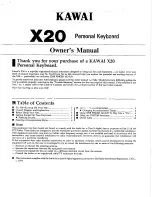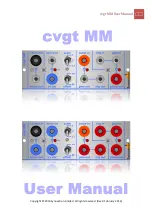
12
PERCUSSIONS
Pressing
DRUMS
⑬
enables 12 rhythmic percussions
on the white and black keys, which are repeated on all 5
octaves of the keyboard.
RECORD/PLAYBACK FUNCTION
This function enables you to record and playback a tune
played on the keyboard. Press
RECORD
⑤
before
playing a tune. When you have finished press
PLAY
⑥
to listen to the tune.
MP3 Player
This keyboard enables you to read
MP3 songs on a USB Flash drive (Pen
Drive) when it is connected to a USB
port at the back of the instrument
㉕
.
After connecting the device, the first
song will automatically start playing
and will be heard from the speakers on the keyboard. To
adjust the volume, keep the
MP3 PLAYER
or
–
button
㉒
pressed; to pause the song, press
PAUSE/
PLAY
㉒
; to go to the next or previous song, press
or
㉒
.
OKON - Learning function
The
O
ne
K
ey
O
ne
N
ote function allows easy playing of
the melody of one of the pre-recorded songs.
Press the
OKON
⑮
button, enter a number from
0
to
59
⑩
to select one from the list at the end of this manual
(the accompaniment starts up); to perform the melody
press any of the keys in succession.
How to read the display notes
Each note has a name: A, B, C, D, E, F, G, in anglo-saxon
notation which correspond to LA, SI, DO, RE, MI, FA, SOL,
in Latin notation and A, H, C, D, E, F, G, in German
notation. This
correspondence
is illustrated on
the next
diagram.
This keyboard displays the notes in the
Anglo-Saxon notation.
SONGS
Some of the songs written with the Bontempi method
can be found at the end of this manual; another 60
songs collected in the "SONG BOOK" can be downloaded
at www.bontempi.com
COMPOSING A SONG
Each song is printed on a separate page. Under the title
there is information regarding:
SOUND
: the sound needed to create the tune
RHYTHM
: the rhythm of the song
TEMPO
: the speed of the song
SONG
: The song number recorded on the keyboard
traditional
writing
simplified
writing
Accompaniment
with left hand
Line showing how long the chord lasts
Numbers that indicate the notes
to be played with the right hand
MARY HAD A LITTLE LAMB
SONG
59
Name of
chord
E A S Y C H O R D
F
C
C L A S S I C C H O R D
F
C
Mar _ y
had
a
lit
_ tle
lamb
5
5
4
6
6
6
6
F
A
A
A
F
G
G
A
SOUND
39 HARMONICA
STYLE
16 POPS
TEMPO
16
You can use this information to configure the keyboard and
play the song at its best. This manual tells you how to select
sound, rhythm and tempo.
The song also indicates:
EASY CHORD
: the easy chords for song accompaniment
CLASSIC CHORD
: the classic chords for song accompani-
ment.
traditional
writing
simplified
writing
Accompaniment
with left hand
Line showing how long the chord lasts
Numbers that indicate the notes
to be played with the right hand
MARY HAD A LITTLE LAMB
SONG
59
Name of
chord
E A S Y C H O R D
F
C
C L A S S I C C H O R D
F
C
Mar _ y
had
a
lit
_ tle
lamb
5
5
4
6
6
6
6
F
A
A
A
F
G
G
A
SOUND
39 HARMONICA
STYLE
16 POPS
TEMPO
16
The song is marked by a
continuous grey strip
that
indicates the numbers used to play the melody with
your right hand. Each key must be pressed for some
time, depending on the distance that separates each
number on the grey strip from the next.
traditional
writing
simplified
writing
Accompaniment
with left hand
Line showing how long the chord lasts
Numbers that indicate the notes
to be played with the right hand
MARY HAD A LITTLE LAMB
SONG
59
Name of
chord
E A S Y C H O R D
F
C
C L A S S I C C H O R D
F
C
Mar _ y
had
a
lit
_ tle
lamb
5
5
4
6
6
6
6
F
A
A
A
F
G
G
A
SOUND
39 HARMONICA
STYLE
16 POPS
TEMPO
16
anglo-saxon
latin
german
E N G L I S H












































